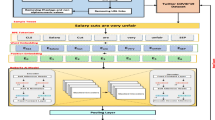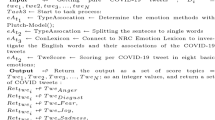Abstract
COVID-19 has scattered around the world since end of year 2019. In the past two years, countless people who have recovered from COVID-19 will still have sequelae. The sequelae are called as long-COVID. Although many people recover without treatment, unfortunately they come across long-COVID effects for weeks or even months. This paper aims to find out the emotions of people towards long-COVID using a machine learning approach based on the data obtained from one of the most popular social media—Twitter. Furthermore, the study deployed the proposed model by developing a prototype named Long COVID Emotion Analyzer. Twitter data were collected using the hash tag Long COVID for a total of five months (i.e., May–September 2021), resulting in 97,098 clean tweets. IBM Watson Tone Analyzer was used to label the emotion of the tweets. (i.e., sadness, joy, fear, anger, analytical, tentative, confident, neutral). Several machine learning algorithms were used to train and test the dataset. Results indicate Logistic Regression with Unigram of Bag of Words to be the best predicting model, with accuracy = 88%, F1-score = 88%, Area Under Curve = 97%.
Access this chapter
Tax calculation will be finalised at checkout
Purchases are for personal use only
Similar content being viewed by others
References
Centers for Disease Control and Prevention (2021, September 16) Post-COVID Conditions. Retrieved from https://www.cdc.gov/coronavirus/2019-ncov/long-termeffects/index.html
Im TL, San PW, On CK, Alfred R, Anthony P (2013) Analysing market sentiment in financial news using lexical approach. IEEE Conference on Open Systems (ICOS) 2013:145–149
Banda JM, Tekumalla R, Wang G, Yu J, Liu T, Ding Y, Chowell G (2021) A large-scale COVID-19 Twitter chatter dataset for open scientific research—an international collaboration. Epidemiologia 2(3):315–324
Chen E, Lerman K, Ferrara E (2020) COVID-19: the first public coronavirus Twitter dataset. arXiv e-prints. arXiv preprint arXiv:2003.07372
World Health Organization (2021) Coronavirus disease (COVID19) pandemic. Retrieved from https://www.who.int/emergencies/diseases/novel-coronavirus2019
Hu B, Guo H, Zhou P, Shi Z-L (2021) Characteristics of SARS-CoV-2 and COVID-19. Nat Rev Microbiol 19(3):141–154
Callard F, Perego E (2021) How and why patients made long COVID. Soc Sci Med 268:113426
Yong SJ (2021) Long COVID or post-COVID-19 syndrome: putative pathophysiology, risk factors, and treatments. Infect Dis 1–18(2021):1924397
Ortony A, Clore GL, Collins A (1990) The cognitive structure of emotions: Cambridge university press
Scherer KR (2005) What are emotions? and how can they be measured? Soc Sci Inf 44(4):695–729
Kabir MY, Madria S (2021) EMOCOV: machine learning for emotion detection, analysis and visualization using COVID19 tweets. Online Soc Netw Media 23:100135
Kulai A, Sankhe M, Anglekar S, Halbe A (2021) Emotion analysis of COVID tweets using fasttext supervised classifier model. In: Paper presented at the 2021 international conference on communication information and computing technology (ICCICT)
Hassan AU, Hussain J, Hussain M, Sadiq M, Lee S (2017) Sentiment analysis of social networking sites (SNS) data using machine learning approach for the measurement of depression. In: Paper presented at the 2017 international conference on information and communication technology convergence (ICTC)
Perikos I, Hatzilygeroudis I (2016) Recognizing emotions in text using ensemble of classifiers. Eng Appl Artif Intell 51:191–201
Da Silva NF, Hruschka ER, Hruschka ER Jr (2014) Tweet sentiment analysis with classifier ensembles. Decis Support Syst 66:170–179
Desmet B, Hoste V (2013) Emotion detection in suicide notes. Expert Syst Appl 40(16):6351–6358
Sailunaz K, Dhaliwal M, Rokne J, Alhajj R (2018) Emotion detection from text and speech: a survey. Soc Netw Anal Min 8(1):1–26. https://doi.org/10.1007/s13278-018
Chekima K, Alfred R (2016) An automatic construction of Malay stop words based on aggregation method. In: International conference on soft computing in data science, Springer, Singapore, pp 180–189
Müller T, Cotterell R, Fraser A, Schütze H (2015) Joint lemmatization and morphological tagging with lemming. In: Paper presented at the proceedings of the 2015 conference on empirical methods in natural language processing
Majumder P, Mitra M, Chaudhuri B (2002) N-gram: a language independent approach to IR and NLP. In: Paper presented at the international conference on universal knowledge and language
Gupta P, Kumar S, Suman R, Kumar V (2020) Sentiment analysis of lockdown in India during COVID-19: a case study on Twitter. IEEE Trans Comput Soc Syst
Author information
Authors and Affiliations
Corresponding author
Editor information
Editors and Affiliations
Rights and permissions
Copyright information
© 2023 The Author(s), under exclusive license to Springer Nature Singapore Pte Ltd.
About this paper
Cite this paper
Ramakrishnan, K., Balakrishnan, V., Han, G.J., Seong, N.K. (2023). Long COVID Emotion Analyzer: Using Machine Learning Approach. In: Kang, DK., Alfred, R., Ismail, Z.I.B.A., Baharum, A., Thiruchelvam, V. (eds) Proceedings of the 9th International Conference on Computational Science and Technology. ICCST 2022. Lecture Notes in Electrical Engineering, vol 983. Springer, Singapore. https://doi.org/10.1007/978-981-19-8406-8_42
Download citation
DOI: https://doi.org/10.1007/978-981-19-8406-8_42
Published:
Publisher Name: Springer, Singapore
Print ISBN: 978-981-19-8405-1
Online ISBN: 978-981-19-8406-8
eBook Packages: Intelligent Technologies and RoboticsIntelligent Technologies and Robotics (R0)




